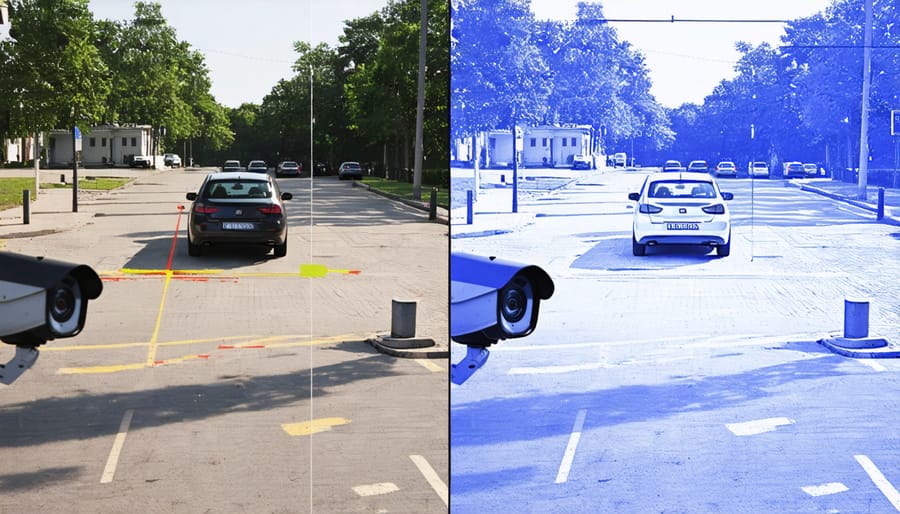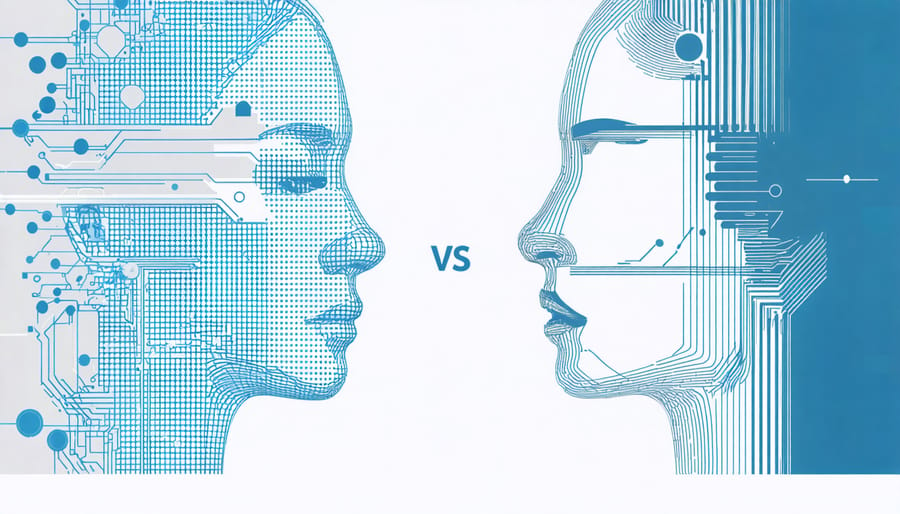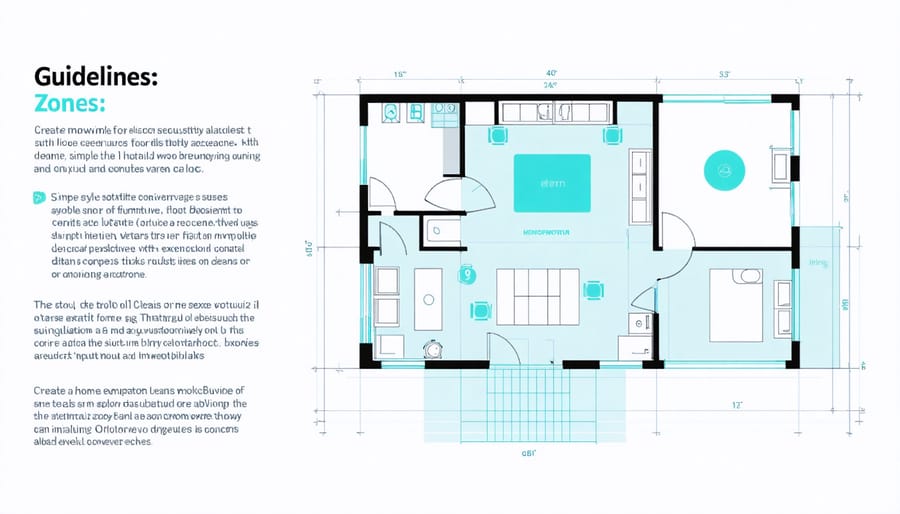Transform your home’s security with AI-powered threat detection that analyzes patterns, predicts potential risks, and responds in real-time. Modern smart home security systems now leverage artificial intelligence to distinguish between routine activities and genuine threats, offering unprecedented protection for your family and property. Gone are the days of simple motion sensors and basic alarms – today’s AI security solutions use advanced algorithms to learn your household’s normal patterns, identify suspicious behavior, and automatically adjust security protocols based on real-world conditions. Whether you’re a tech-savvy homeowner or just starting to explore home automation, understanding AI threat modeling can help you make informed decisions about protecting what matters most. Let’s explore how this game-changing technology works and how you can implement it effectively in your home security strategy.
How AI Threat Detection Actually Works in Your Home
Computer Vision and Smart Cameras
Modern AI-powered security cameras are like having an attentive guard who never gets tired or distracted. These smart cameras use advanced computer vision technology to process visual information in real-time, helping you keep your home safe and secure.
When your security camera captures video footage, the AI system breaks down each frame into patterns, shapes, and movements. It’s trained to recognize the difference between normal activities (like your cat walking across the yard) and potential threats (like someone attempting to break in). This works through a process called machine learning, where the system gets better at identifying threats over time.
The AI can detect specific actions that might indicate suspicious behavior, such as lingering around entry points, attempting to conceal one’s face, or moving in unusual patterns. It can also distinguish between people, vehicles, animals, and objects, reducing false alarms that might otherwise be triggered by harmless movement.
What makes these systems particularly helpful for homeowners is their ability to send instant notifications when something suspicious is detected. Instead of having to watch hours of footage, you’ll receive alerts only when there’s something that needs your attention. The system can even highlight the specific area of concern in the video, making it easier to assess the situation quickly.
These smart cameras can also learn your household’s routine patterns, making their threat detection more accurate over time. For instance, they’ll know that movement in your driveway at 5 PM is likely just you returning from work, while similar movement at 3 AM might warrant closer attention.

Pattern Recognition and Behavioral Analysis
Think of AI security systems as vigilant neighbors who learn your daily routines. These smart systems observe and understand normal patterns in your home – like when family members typically come and go, regular delivery times, and usual movement patterns around your property.
Over time, the AI builds a detailed picture of what’s “normal” for your household. When something unusual happens, like movement at odd hours or unfamiliar patterns of activity, the system can quickly identify these anomalies and alert you. It’s similar to how you might notice something out of place in your own routine.
For example, your AI security system might learn that package deliveries usually happen between 2-4 PM on weekdays. If someone approaches your porch at 3 AM, it recognizes this as suspicious behavior and sends you an immediate alert. The system can also distinguish between a neighbor’s cat crossing your yard (normal occurrence) and a person lingering suspiciously near your windows (potential threat).
What makes this technology particularly helpful is its ability to reduce false alarms. Traditional security systems might trigger an alert for any movement, but AI-powered systems understand context. They can tell the difference between your teenager coming home late from study group and an actual security threat, making your home security both smarter and more reliable.

Real Benefits of AI Security for Your Family
Fewer False Alarms, More Real Protection
One of the biggest frustrations with traditional security systems is the constant stream of false alarms that can make you feel like you’re crying wolf. AI-powered threat modeling is changing this by bringing a smarter approach to how we protect your family and property.
Think of AI as your highly trained security guard who can tell the difference between a swaying tree branch and an actual intruder. Using advanced pattern recognition, these systems learn what’s normal in your home environment – your daily routines, pet movements, and even regular delivery schedules. This means fewer heart-stopping moments when your cat triggers the alarm at 3 AM!
The real magic happens in how AI processes information from multiple sensors simultaneously. When your security cameras detect movement, the AI cross-references this with other data points – time of day, whether you’re usually home, weather conditions, and even recent activity patterns. This comprehensive analysis helps the system make more accurate decisions about what constitutes a genuine threat.
For example, if someone approaches your front door during typical delivery hours with a package, the AI recognizes this as normal behavior. However, if someone lingers around your windows at midnight, the system immediately flags this as suspicious activity. This intelligent discrimination means you’ll get alerts when they really matter, making your security system more reliable and effective in keeping your home safe.
Best of all, these systems continue to learn and adapt over time, becoming even more accurate at distinguishing between routine activities and genuine security concerns.
Personalized Security That Adapts
Modern AI-powered security systems are like attentive guardians that learn and adapt to your family’s daily routines. Instead of relying on rigid, one-size-fits-all rules, these smart systems observe patterns in your household’s activities to provide more accurate and personalized protection.
Think of it as having a security system that knows when your teenagers typically return from after-school activities or when your work-from-home schedule means more daytime activity. Over time, the AI learns these patterns and can distinguish between normal behavior and potential threats. For example, if someone typically enters through your back door at 3 PM for dog walking services, the system recognizes this as routine rather than triggering unnecessary alerts.
The learning process is continuous and remarkably precise. The system picks up on subtle details like preferred entry points, typical movement patterns through your home, and even regular delivery schedules. This adaptive intelligence means fewer false alarms and more reliable protection when it really matters.
What makes this particularly valuable is the system’s ability to adjust to changes in your routine. Planning a vacation? The AI will notice the deviation from normal patterns and enhance monitoring. Having house guests for a week? The system will temporarily adapt to the increased activity without compromising security.
Best of all, you maintain complete control over these learning features. You can review the patterns the system has identified, make manual adjustments, and even set specific exceptions for special occasions. This blend of intelligent automation and user control creates a security solution that truly works in harmony with your lifestyle while keeping your home safe.
Setting Up Your AI Security System Right
Essential Components and Placement
When setting up AI-powered security monitoring, proper component placement is crucial for optimal protection. Start with a central hub or control panel, which should be installed in an easily accessible location like your entryway or home office. This serves as the brain of your security system, processing data from various sensors and cameras.
Smart cameras with AI capabilities should be positioned at key entry points: your front door, back door, and first-floor windows. For outdoor placement, install cameras under eaves or protected areas to shield them from weather while maintaining clear sight lines. Consider placing additional cameras in high-traffic areas like your driveway or garage.
Motion sensors work best when mounted in corners at about 6-8 feet height, angled slightly downward. Place these in areas where intruders would likely pass through, such as hallways and main living spaces. Door and window sensors should be installed on all ground-level entry points, ensuring proper alignment between the sensor and magnet components.
For optimal AI learning, ensure your WiFi network provides strong coverage to all device locations. A mesh network system might be necessary for larger homes. Remember to position your backup power supply in a cool, dry location, preferably near your main control panel. This setup ensures continuous protection even during power outages while maximizing the effectiveness of your AI security features.

Initial Configuration Tips
To get the most out of your AI-powered threat modeling system, proper initial setup is crucial. Start by carefully mapping out your home’s layout, identifying key entry points and vulnerable areas that need monitoring. When setting up your security system, place cameras and sensors at optimal heights and angles for maximum coverage.
Configure your AI settings to recognize familiar faces, including family members and regular visitors, to reduce false alarms. Set different security modes for various scenarios – ‘Home,’ ‘Away,’ and ‘Night’ – each with appropriate sensitivity levels. Remember to establish clear zones within your property where movement is expected versus areas that should remain movement-free.
Connect your system to a reliable, high-speed internet connection and ensure you have a backup power supply. Set up mobile notifications that make sense for your lifestyle – you might want immediate alerts for unexpected movement but delayed notifications for regular activities like mail delivery.
Take time to test your system thoroughly during different times of day and weather conditions. Adjust sensitivity settings based on real-world performance, and don’t forget to create backup access methods in case of system failures. Regular updates and maintenance checks will keep your AI threat modeling system running smoothly and effectively protecting your home.
Privacy and Data Security Considerations
When it comes to AI-powered home security, privacy and data protection are understandably top concerns for many homeowners. The good news is that modern AI security systems are designed with robust privacy features and multiple layers of protection. Your security footage and personal data are typically encrypted both during storage and transmission, making it extremely difficult for unauthorized access.
To maintain your privacy, most AI security systems allow you to customize detection zones and create privacy masks for sensitive areas. This means you can block out neighbors’ windows or public spaces from being recorded, respecting both your privacy and that of others. Many self-monitored security options also store data locally rather than in the cloud, giving you complete control over your information.
Here are some practical steps to enhance your AI security system’s privacy:
1. Regularly update your system’s firmware and software
2. Use strong, unique passwords and enable two-factor authentication
3. Connect your security devices to a separate network from your main home network
4. Review and adjust privacy settings monthly
5. Choose systems with end-to-end encryption
It’s worth noting that reputable AI security manufacturers are required to comply with data protection regulations and typically provide transparent privacy policies. They often include features like automatic video deletion after a set period and the ability to download or delete your data at any time.
Remember that while privacy is crucial, it shouldn’t come at the expense of security. Modern AI systems strike a careful balance between protecting your home and safeguarding your personal information. By understanding and properly configuring your system’s privacy settings, you can enjoy the benefits of AI-powered security while maintaining control over your personal data.
As we look to the future of home security, AI threat modeling stands as a game-changing technology that’s making our homes safer and smarter. By understanding potential threats and automatically adapting to new security challenges, AI-powered systems are becoming increasingly sophisticated while remaining user-friendly for the average homeowner.
Throughout this guide, we’ve explored how AI analyzes patterns, detects unusual activities, and helps prevent security breaches before they happen. The combination of smart cameras, doorbell systems, and AI-powered monitoring creates a comprehensive security shield that works tirelessly to protect your home and loved ones.
Looking ahead, we can expect even more exciting developments in AI home security. From improved facial recognition to better integration with smart home devices, the technology continues to evolve. Future systems will likely offer more personalized protection, learning from your household’s specific routines and preferences to provide even more effective security.
Remember, implementing AI threat modeling doesn’t mean completely replacing traditional security measures – it’s about enhancing them. Start small with basic AI-powered cameras or doorbell systems, and gradually build up your security network as you become more comfortable with the technology.
By staying informed about AI security developments and regularly updating your system, you’ll be well-positioned to protect your home both now and in the future. The peace of mind that comes with knowing your home is protected by cutting-edge AI technology is truly invaluable.
